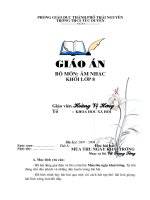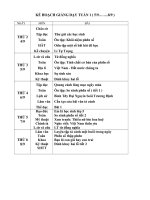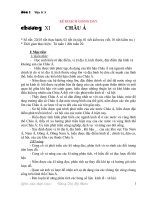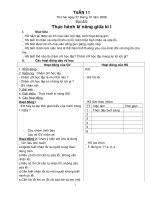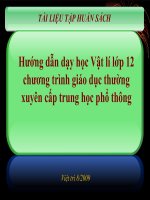BÀI GIẢNG LỚP Y SỸ pe cardiovoascular exam
Bạn đang xem bản rút gọn của tài liệu. Xem và tải ngay bản đầy đủ của tài liệu tại đây (2.78 MB, 41 trang )
Examination Of The
Cardiovascular System
Charlie Goldberg, M.D.
Professor of Medicine, UCSD SOM
Review of Systems
• All organ systems have a review of
symptoms
• Questions designed to uncover problems
in that area
• Clinicians need to know the right questions
– as well as what the responses might
mean!
• Example:
/>
Cardiovascular Exam
• Includes Vital Signs (see earlier lecture), in
particular:
– Blood pressure
– Pulse: rate, rhythm, volume
• Includes Pulmonary Exam (coming soon)
• Includes (today) assessment distal
vasculature (legs, feet, carotids) - vascular
disease (atherosclerosis) systemic!
• 4 basic components:
– Observation, Palpation, Percussion
(omitted in cardiac exam) & Auscultation
Thoughts On Gown Management &
Appropriately/Respectfully Touching
Your Patients
• Several Sources of Tension:
– Area examined reasonably exposed – yet patient
modesty preserved
– Palpate sensitive areas to perform accurate exam requires touching people w/whom you’ve little
acquaintance – awkward, particularly if opposite
gender
– Exam not natural/normal part of interpersonal
interactions - as newcomers to medicine, you’re
particularly aware & hence sensitive a good thing!
Keys To Performing a Respectful &
Effective Exam
• Explain what you’re doing (& why) before doing it
acknowledge “elephant in the room”!
• Expose minimum amount of skin necessary - “artful” use
of gown & drapes (males & females)
• Examining heart & lungs of female patients:
– Ask pt to remove bra prior (can’t hear well thru fabric)
– Expose side of chest to extent needed
– Enlist patient’s assistance positioning breasts to enable
cardiac exam
• Don’t rush, act in a callous fashion, or cause pain
• PLEASE… don’t examine body parts thru gown:
– Poor technique
– You’ll miss things
– You’ll lose points on scored exams (OSCE, CPX, USMLE)!
Hammer & Nails icon indicates A Slide
Describing Skills You Should Perform In Lab
Observation
• Pay attention to:
– Chest shape
– Shortness of breath (@ rest or walking)?
– Sitting upright? Able to speak?
– ? Visible impulse on chest wall from
vigorously contracting ventricle (rare)
Surface Anatomy
Finding The Sternal Manubrial Angle
(AKA Angle of Louis) – Key To
Identifying Valve Areas
Clavicle
Clavicle
Manubrium
Manubrium
Sternum
Angle of
Louis
1st Rib
Angle
Of Louis
2nd Rib
2nd ICS
Sternum
Manubrium slopes in one direction while Sternum angles in different
direction. Highlighted by q-tipsintersection defines Angle of Louis.
Valves And Surface Anatomy
• Areas of auscultation correlate w/rough
location of ea valve
• Where you listen will determine what you hear!
More Anatomy @:
Blaufuss Medical
University of Toronto: PIE Group
Palpation
Right Ventricle
• Vigor of contractility
– Felt with heel of hand
– Prominence described as
a “lift” or “heave”
• Thrill – rare palpable
sensation associated
w/regurgitant or stenotic
murmurs (feels like
sensation when kink
garden hose)
Palpation - Technique
L ventricle
- Fingers across chest,
under breast (explain 1st to
female pts!)
– Point of Maximal Impulse
(PMI) apex ventricle that
pin-points w/finger tip;
~70% of patients - if not
palpable, repeat w/patient
on L side
- Size of LV – increased
dimension if PMI shifted to
L of mid-clavicular line
– Vigor of contraction
– Palpable thrill (rare)
For Male Patients
For Female Patients
Palpation – Technique (cont)
• Right ventricle:
– Vigor of contractility
heel of R hand along
sternum
Auscultation: Using Your
Stethescope
They all work - most
important part is
what goes between
the ear pieces!
DiaphragmHigher
pitched sounds
Bell Lower pitched
What Are We Listening For?
• Normal valve closure
creates sound
• First Heart Sound =s
S1 closure of Mitral,
Tricuspid valves
• Second Heart Sound
=s S2 closure of
Pulmonic, Aortic
valves
Courtesy Wilbur Lew, M.D.
What Are We Listening For? (cont)
• Systole =s time between
S1 & S2; Diastole =s
time between S2 & S1
• Normally, S1 & S2 =
distinct sounds
• Physiologic splitting =s
2 components of second
heart sound (Aortic &
Pulmonic valve closure)
audible w/inspiration
Ohio State University – Heart Sound
Simulations and their
Physiological Basis
Auscultation Technique
• Patient lying @ 30-45 degree incline
• Chest exposed (male) or loosely fitted gown
(female)
– need to see area where placing stethescope
– stethescope must contact skin
• Stethescope w/diaphragm (higher pitched
sounds) engaged
Remember – Don’t Examine Thru Clothing or
“Snake” Stethoscope Down Shirts/Gowns !
NO!
NO!
QuickTime™ and a
decompressor
are needed to see this picture.
NO!
NO!
Good Exam Options When
Ausculting Female Patients
Auscultation Technique (cont)
1. Start over Aortic area2nd Right Intercostal
Space (ICS) – Use Angle of Louis as landmark
2. Pulmonic area (2nd L ICS)
3. Inch down sternal border Tricuspid area (4th
L ICS)
4. Inch towards Mitral area (4th ICS, midclavicular)
Listen in ~ 6 places - precise total doesn’t matter –
gives you sense of change In sounds as
change location
Auscultation
• In each area, ask yourself:
– Do I hear S1? Do I hear S2?
Which is louder & what are
relative intensities?
• Interval between S1 & S2
(systole) is shorter then between
S2 & S1 (diastole)
• Can also determine timing by
simultaneously feeling pulse (a
systolic event)
• Listen for physiologic splitting of
2nd heart sound w/inspiration
Murmurs
• Murmurs: Sound created by
turbulent flow across valves:
– Leakage (regurgitation) when
valve closed
– Obstruction (stenosis) to flow
when normally open
• Systolic Murmurs:
– Aortic stenosis, Mitral
regurgitation (Pulmonary
stenosis, Tricuspid regurgitation)
• Diastolic Murmurs:
– Aortic regurgitation, Mitral
stenosis (Pulmonary
regurgitation, Tricuspid stenosis)
Murmurs (cont)
• Characterized by: position in cycle, quality, intensity, location,
radiation; can try to draw it’s shape:
• Intensity Scale:
1 –barely audible 2- readily audible 3- even louder 4- loud + thrill
5- audible with only part of diaphragm on chest 6 – audible w/out
stethescope
• intensity doesn’t necessarily correlate w/severity
• Some murmurs best appreciated in certain positions:
Mitral: patient on L side; Aortic: sitting up and leaning forward
• Example – Mitral Regurgitation: Holosystolic, loudest in mitral
area, radiates towards axilla.
UCLA Heart Sound Simmulator
Blaufuss Medical
Extra Heart Sounds – S3 & S4
• Ventricular sounds, occur during diastole
– normal in young patient (~ < 30 yo)
– usually LV, rarely RV
• S3 follows S2
– caused by blood from LA colliding w/”left over”
blood in LV
– assoc w/heart failure.
• S4precedes S1
– caused during atrial systole
– when blood squeezed into non-compliant LV
– assoc w/HTN
Extra Heart Sound (cont)
• S3 & S4 are soft, low pitched
• Best heart w/bell, laid over LV, w/patient lying
on L side (brings apex of heart closer to chest
wall) – can also check over RV (4th ICS, L
parasternal)
• Abnormal beyond age ~30
• When present, S3 or S4 are referred to as
“gallops”
S3 & S4 Simulator:
Ohio State University – Heart Sound Simulations and their
Physiological Basis
Auscultation – An Ordered
Approach
• Do I hear S1? Do I hear S2?
– Listen in ea major valvular area – think about which sound
should be loudest in ea location (S1 loudest region of TV & MV,
S2 loudest AV & PV)
• Do I hear physiologic splitting of S2?
• Do I hear something before S1 (an S4) or after S2 (an
S3)?
• Do I hear murmur in systole? In diastole?
• If a murmur present, note:
– intensity, character, duration, radiation
• As listen, think about mechanical events that generate
the sounds.
